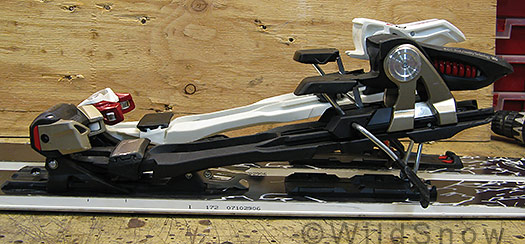
Marker Duke (2009) in front, Tour in rear. Tour heel lifter is 15 mm higher in high lift, and 9 mm higher in low lift position.
One thing to remember about the Marker Duke/Baron/Tour series of bindings: While they are super stiff in alpine mode, they’re a bit twisty and sloppy when you’ve got your heel unlatched in tour mode. Why? Simply because these bindings eliminate weight by using a minimalist frame connecting toe and heel, but in alpine mode the twisting of said frame is eliminated by a beefy attachment plate located on the ski under the binding heel. We don’t fault the bindings for this, as it’s impossible to keep the weight of a ski binding down and have it do everything perfectly. But it is important to get clear on what’s going on with Markers so vague internet rumors of “heel slop in touring mode” don’t cause undue concern.
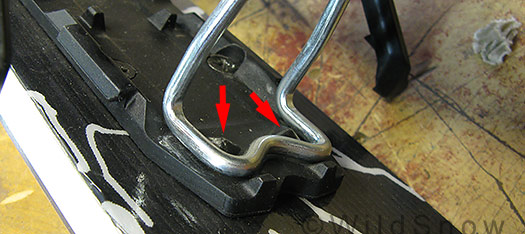
Marker Duke/Baron heel lift. Side movement is resisted by the small bumps fitting inside the wire foot. But the foot easily slides to the side off the bumps.
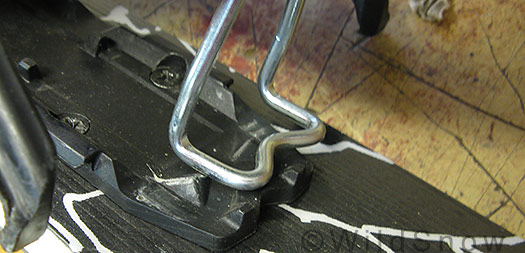
Marker Duke/Baron heel lift slipped to the side, off small bumps designed to resist this type of movement.
Marker attempts to mitigate binding slop in touring mode by building various “catch” systems into the heel lifter. Our 2009 tester Duke is fairly basic, with a bent wire lifter that falls between bumps on the attachment plate. This works to a degree, but once you have ice build up on the plate the lifter foot slips to the side, and you end up with quite a bit of movement. Likewise, with enough force and torque, say on a sidehill, you can end up with the lifter foot falling off the edge of the plate when you set your heel down after a stride, thus allowing disconcerting slop.
Marker’s Tour F12/10 tend to flex sideways just as the Duke/Baron does, but it has a more sophisticated heel lifter that may do a better job of mitigating this. The way it works is the lifter has teeth on its foot, which mate with a series of notches on the plate that’s attached to the ski.
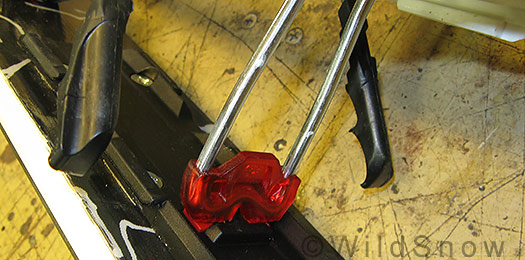
Marker Tour heel lifter foot has small notches that mate with the red bumps. It doesn't slip sideways as easily as the Duke/Baron system, but the Tour binding frame is just as flexible as that of the Duke/Baron.
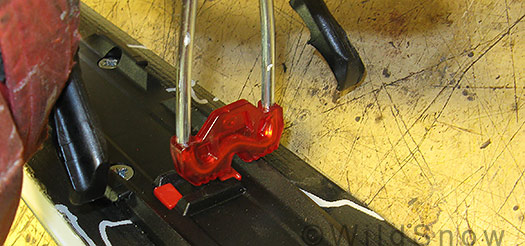
Marker Tour heel lift foot torqued to the side doesn't fall on the catches that help keep it stable. We feel this system works better than that of the Duke/Baron, but is still not ideal.
Thing to realize with this is if you’re doing something like a sidehill or kickturn with any of the Marker touring capable bindings, you can easily flex your boot heel to the side BEFORE the heel lifter foot engages the plate on the ski. Then, as you bring your heel down, the lifter foot will sit down to the side of where it’s supposed to be, and you notice a lot of binding torque. Key is to use good technique and pay attention to this issue. More, while Marker does provide what is probably the most “alpine” like of all touring bindings, behavior of the binding’s heel lift is definitely a compromise to be aware of.
That said, you can flex a Fritschi to the side fairly easily, and the Silvretta Pure models are quite sloppy as well. The most solid in touring mode are the tech bindings, since they use the rigid boot sole as the binding heel/to connector frame.
WildSnow.com publisher emeritus and founder Lou (Louis Dawson) has a 50+ years career in climbing, backcountry skiing and ski mountaineering. He was the first person in history to ski down all 54 Colorado 14,000-foot peaks, has authored numerous books about about backcountry skiing, and has skied from the summit of Denali in Alaska, North America’s highest mountain.
